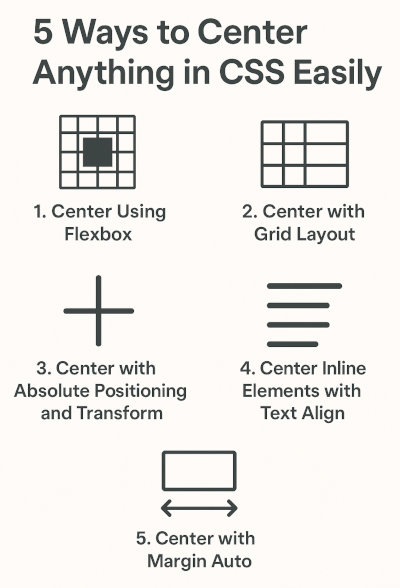5 Ways to Center Anything in CSS Easily
Centering elements in CSS can be tricky, especially with the wide variety of layout techniques available today. Whether you're working with text, blocks, flex containers, or grid items, there are several reliable methods to center content both horizontally and vertically. In this post, we'll cover five easy and modern ways to center any HTML element in CSS, helping you simplify your layout designs and improve your workflow.

1. Center Using Flexbox
Flexbox is one of the most versatile layout modules in CSS. You can center content horizontally and vertically with just a few lines of code. This method works well for both inline and block elements inside a flex container.
.container {
display: flex;
justify-content: center;
align-items: center;
height: 100vh;
}
The justify-content: center centers items horizontally, while align-items: center centers them vertically. The height: 100vh ensures the container takes the full viewport height.
2. Center with Grid Layout
CSS Grid provides a concise way to center items using grid properties. It's especially useful when you're designing a layout with multiple items and want to center a specific one.
.container {
display: grid;
place-items: center;
height: 100vh;
}
The place-items: center shorthand sets both justify-items and align-items to center, achieving perfect centering in both axes.
3. Center with Absolute Positioning and Transform
This classic technique uses absolute positioning combined with transform properties. It's widely compatible with older browsers and still effective for simple centering tasks.
.element {
position: absolute;
top: 50%;
left: 50%;
transform: translate(-50%, -50%);
}
By moving the top-left corner of the element to the center of the parent and then translating it back by 50% of its own width and height, you achieve perfect centering.
4. Center Inline Elements with Text Align
When working with inline or inline-block elements like text or images, you can center them using the text-align property on the parent container.
.container {
text-align: center;
}
.element {
display: inline-block;
}
Setting text-align: center on the parent causes all inline-level elements to align to the center. Adding display: inline-block ensures that block-level elements can behave like inline ones.
5. Center with Margin Auto
For block-level elements, especially fixed-width elements, using margin: auto is a quick and simple way to center horizontally.
.element {
width: 400px;
margin: 0 auto;
}
When a block element has a fixed width, setting the left and right margins to auto will push it into the center of the parent container.
Vertical Centering with Line Height
If you're working with a single-line text inside an element of fixed height, you can use line-height equal to the container's height to center it vertically.
.element {
height: 50px;
line-height: 50px;
text-align: center;
}
Note: This method only works for single-line text and may not be suitable for multiline content.
Whether you're using modern layout techniques like Flexbox and Grid or sticking with classic methods like absolute positioning, CSS offers many ways to center elements effectively. The best approach depends on your layout context, content type and browser support requirements. By mastering these five techniques, you'll be equipped to handle almost any centering challenge in your projects.
More CSS Tips
Most Common CSS Mistakes and How to Avoid Them CSS Tutorial: Div with Background Video CSS Tutorial: Div with Background Image How to Hide Scrollbars with CSS CSS Full Screen Video Background Tutorial CSS Full Screen Background Image Tutorial CSS Browser Compatibility: What You Should Avoid Double Underline and Double Overline Text with CSS Designing a Simple Testimonial Box with CSS
CSS Tips